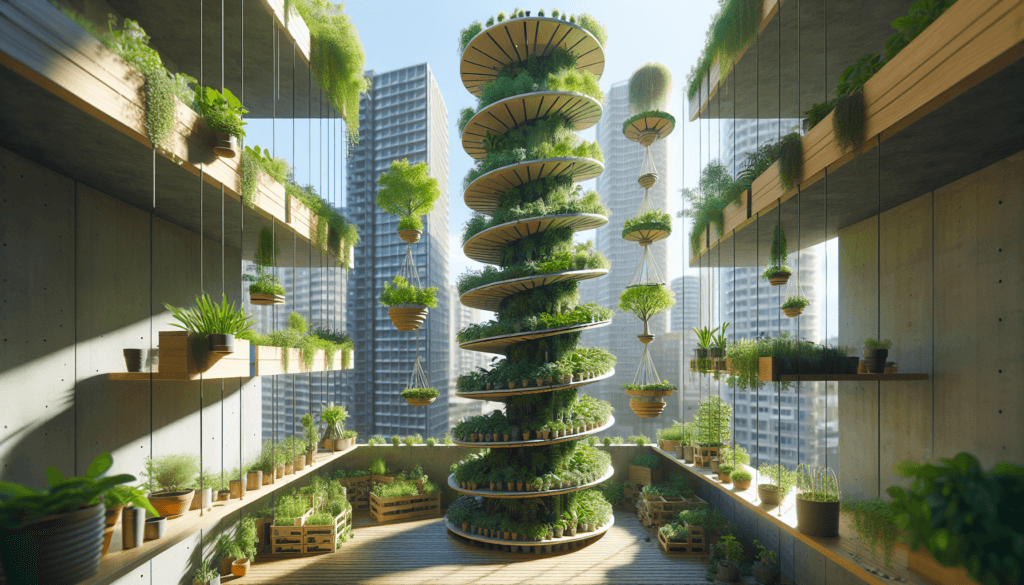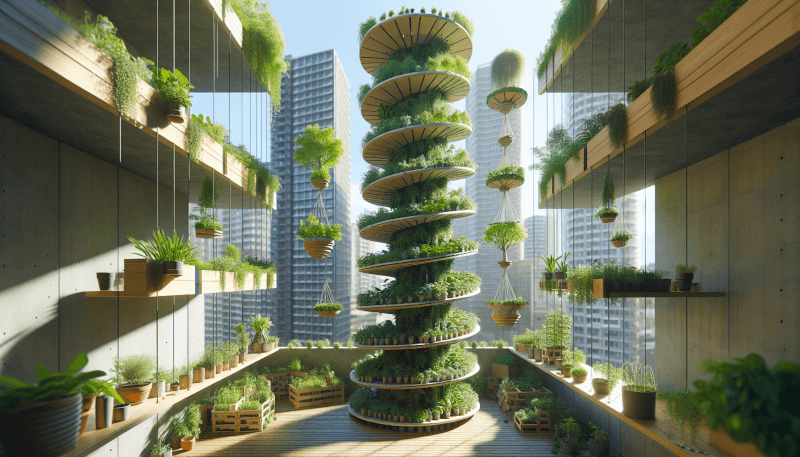Are you eager to begin your own garden, but feel deterred by limited space? Look no further! This article will guide you through the exciting world of urban gardening and show you how to make the most out of your small spaces by utilizing vertical space. Discover the wonders of cultivating plants, herbs, and even vegetables, all within the comfort of your urban dwelling. With a bit of creativity and resourcefulness, you can transform any narrow balcony or tiny backyard into a flourishing oasis. Say goodbye to the constraints of traditional gardening and unlock the endless possibilities of urban gardening in small spaces.
Benefits of Urban Gardening
Environmental Impact
Urban gardening can have a significant positive impact on the environment. By utilizing vertical space, urban dwellers can transform bare walls, balconies, rooftops, and windows into lush green spaces. This helps in reducing the urban heat island effect, improving air quality, and mitigating the negative effects of climate change. Plants absorb carbon dioxide and release oxygen, making cities healthier and more livable. Moreover, urban gardens help in conserving water by reducing runoff and providing natural irrigation.
Health Benefits
Engaging in urban gardening not only beautifies the surroundings but also offers numerous health benefits. Spending time outdoors and connecting with nature has been scientifically proven to reduce stress, lower blood pressure, and improve overall mental well-being. Urban gardeners often experience a sense of accomplishment and satisfaction as they watch their plants grow and flourish. Furthermore, growing your own fresh produce allows you to consume nutritious, organic food, leading to a healthier and more sustainable lifestyle.
Utilizing Vertical Space
Vertical Planters
Vertical planters are a versatile and space-efficient solution for growing plants in small urban areas. These planters can be easily mounted on walls or fences, allowing you to maximize your gardening space. They come in various sizes and designs, from pocket planters to modular systems, providing options to fit any space or aesthetic preference. Vertical planters are especially popular for growing herbs, flowers, and compact vegetables.
Hanging Gardens
Hanging gardens are an excellent way to utilize vertical space in urban environments. By suspending plant containers from ceilings, hooks, or specially designed structures, you can create a beautiful and functional garden in areas with limited floor space. Hanging gardens add a unique visual element to any space and can be easily customized to match your personal style. They are particularly suitable for growing trailing plants, flowers, and small ornamental species.
Trellis Systems
Trellis systems offer a practical and visually appealing solution for vertical gardening. These structures provide support for climbing plants, such as vines, cucumbers, and tomatoes. By attaching plants to trellises, you can save ground space and create a stunning vertical display. Trellis systems can be installed against walls, fences, or standalone frames, offering flexibility in design and placement. They not only enhance the aesthetic of urban spaces but also make harvesting and maintenance more convenient.
Living Walls
Living walls, also known as green walls or vertical gardens, are an innovative way to utilize vertical space while adding beauty and biodiversity to urban areas. These vertical structures consist of carefully selected plants grown in specially designed modules attached to walls or freestanding frames. Living walls provide numerous benefits, including improved air quality, noise reduction, and temperature regulation. They also act as habitats for birds, bees, and other wildlife, fostering biodiversity in urban environments.

Choosing Plants for Vertical Gardening
Vertical Climbers
Vertical climbers are plants that naturally have a climbing or trailing habit, making them ideal for vertical gardening. Some popular vertical climbers include ivy, jasmine, climbing roses, and clematis. These plants can be trained to grow upwards or horizontally, creating a stunning visual effect on walls or trellises. Vertical climbers not only add a touch of greenery to urban spaces but also provide shade, privacy, and habitat for beneficial insects and birds.
Compact Plants
In small urban spaces, it is crucial to choose plants that have a compact growth habit. Compact plants, such as dwarf varieties of vegetables, herbs, and flowers, are well-suited for vertical gardening as they require less space for their roots and foliage. They are also easier to manage and maintain. Compact plants come in a wide range of sizes, colors, and shapes, allowing urban gardeners to create visually appealing displays in even the tiniest spaces.
Herbs and Edibles
Vertical gardening is an excellent opportunity to grow your own herbs and edibles, even in limited spaces. Herbs, such as basil, thyme, mint, and parsley, thrive in vertical planters, hanging baskets, or living walls. They not only add a burst of flavor to your dishes but also offer medicinal and aromatic benefits. Edible plants like cherry tomatoes, peppers, lettuce, and strawberries can also be successfully grown in vertical gardens, providing a fresh and convenient source of homegrown produce.
Vertical Gardening Techniques
Espalier
Espalier is a technique of training plants, typically fruit trees, to grow in a flat, two-dimensional form against a wall, fence, or trellis. This technique not only saves space but also creates an artistic display of plants. The branches can be pruned and manipulated to create intricate designs or simple shapes, such as fans or horizontal tiers. Espaliered fruit trees are not only aesthetically pleasing but also produce abundant fruit in urban settings without requiring large growing areas.
Training and Pruning
Training and pruning are essential techniques for maintaining the shape and growth of plants in vertical gardens. By consistently guiding the plants’ stems and branches in the desired direction, you can promote upward growth and prevent overcrowding. Pruning helps to control the size of plants, remove dead or diseased branches, and stimulate new growth. Regular training and pruning ensure that plants in vertical gardens remain healthy, visually appealing, and productive.
Layering
Layering is a technique where multiple plants are grown vertically, with one layer overshadowing the layer below. This method allows you to maximize space and create a lush, layered look. Tall plants, such as sunflowers or corn, can provide shade for shorter plants like lettuce or radishes. By carefully selecting plants with varying heights, foliage textures, and bloom times, you can create an aesthetically pleasing and dynamic vertical garden design.
Hydroponics
Hydroponics is a soilless gardening technique that allows plants to grow in nutrient-rich water solutions. This method is particularly suitable for vertical gardening as the plants’ roots are suspended in the water system, reducing the need for soil and saving space. Hydroponic systems provide precise control of nutrient levels, pH, and water supply, resulting in faster growth and higher yields. This innovative technique allows urban gardeners to grow a wide range of plants, from leafy greens to tomatoes, with limited resources.
Aeroponics
Aeroponics is a vertical gardening technique that involves suspending plants in the air and misting their exposed roots with a nutrient-rich mist. This method allows for maximum oxygen exposure to the roots, promoting rapid growth and increased water efficiency. Aeroponics is an ideal solution for vertical gardening as it requires minimal space and provides excellent aeration to the plants. It is especially popular for cultivating herbs, leafy greens, and small ornamental plants in urban settings.

Designing Your Vertical Garden
Assessing Your Space
Before designing your vertical garden, it is essential to assess your available space and its specific conditions. Consider factors such as sunlight exposure, wind patterns, and the structural integrity of walls or structures where you plan to install your vertical garden. Assessing your space will help you determine the type and size of vertical gardening systems that are suitable for your specific circumstances.
Creating Layers
Creating layers in your vertical garden adds depth and visual interest to the space. Start by choosing plants with varying heights and foliage textures. Place taller plants towards the back or center of the design, with shorter plants in front. Consider using trellises or hanging baskets to add vertical elements within the garden. Creating layers not only enhances the aesthetics of the vertical garden but also ensures that light reaches the lower plants and allows for better air circulation.
Color Combinations
Choosing a color scheme for your vertical garden can help create a cohesive and visually appealing look. Consider the colors of the surrounding environment and select plants with complementary or contrasting hues. Use a mix of vibrant and subdued colors to add interest and create focal points. Remember to take into account the changing colors of plants throughout the seasons, ensuring that your vertical garden remains visually appealing year-round.
Lighting Considerations
Lighting is a crucial factor in the success of your vertical garden. Assess how much natural light your space receives throughout the day and determine if additional artificial lighting is necessary. Many plants thrive in bright, indirect light, while others require more shade. Consider placing shade-loving plants in areas where they won’t be exposed to intense sunlight, and sun-loving plants where they will receive ample light. Install appropriate lighting fixtures to provide the necessary light levels for your plants, especially in areas with limited natural light.
Maintaining a Vertical Garden
Irrigation Systems
Proper irrigation is essential for the health and vitality of plants in a vertical garden. Depending on the design and size of your vertical garden, you may opt for drip irrigation systems, micro-sprinklers, or self-watering planters. These systems ensure that plants receive a consistent and adequate water supply, reducing water wastage and promoting healthy growth. Regularly monitor the moisture levels of the soil or growing medium, and adjust your irrigation system accordingly to prevent over or under-watering.
Managing Soil Health
Maintaining healthy soil is crucial for the long-term success of your vertical garden. Consider using a well-draining soil mixture specifically formulated for container gardening. Regularly amend the soil with organic matter or compost to improve its structure, fertility, and water-holding capacity. Additionally, monitor the pH levels of the soil and adjust accordingly to meet the specific needs of your plants. Proper soil maintenance will ensure that your plants receive the necessary nutrients and support for optimal growth.
Pest Control
Given the confined space of urban gardens, pests can quickly become a problem for your vertical garden. Implement preventive measures such as regularly inspecting your plants for signs of pests or diseases, and promptly removing any affected plant material. Encourage natural predators, such as ladybugs or lacewings, by incorporating companion planting or providing suitable habitats. Consider using organic pest control methods, such as neem oil or insecticidal soap, to minimize the impact on the environment. Regularly monitor and address pest issues to ensure the health and vitality of your vertical garden.

Urban Gardening In Small Spaces: Success Stories
Urban Farming Innovations
In recent years, urban farming innovations have revolutionized the way we utilize small spaces for gardening. From rooftop greenhouses to vertical hydroponic farms, urban farmers have been successfully growing a wide variety of crops in the heart of the city. These innovative systems make use of advanced technologies, such as automated irrigation, energy-efficient lighting, and climate control devices, to optimize plant growth and maximize yields. Urban farming innovations are not only environmentally sustainable but also economically viable, providing fresh and locally grown produce to urban communities.
Rooftop Gardening Examples
Rooftop gardens have become increasingly popular in urban areas as they allow for the conversion of otherwise unused spaces into vibrant green oases. Successful rooftop gardens can be found in many cities around the world, including New York, London, and Singapore. These gardens showcase creative and sustainable designs, utilizing a combination of vertical planters, rainwater harvesting systems, and efficient irrigation techniques. Rooftop gardens not only provide an escape from the concrete jungle but also contribute to temperature regulation, stormwater management, and biodiversity preservation.
Community Vertical Gardens
Community vertical gardens are excellent examples of how urban residents can come together to transform shared spaces into flourishing green landscapes. These gardens can be found in public parks, schools, community centers, or even on the exterior walls of buildings. They promote a sense of community, foster environmental stewardship, and provide educational opportunities for residents of all ages. Community vertical gardens often feature a diverse range of plants, including fruits, vegetables, flowers, and native species. They are symbols of communal pride, environmental awareness, and sustainable living.
DIY Vertical Gardening Projects
Upcycled Vertical Planters
Upcycled vertical planters are a creative and environmentally friendly way to repurpose everyday items into unique gardening solutions. Old pallets, wooden crates, tin cans, and even unused furniture can be transformed into charming vertical planters. All you need is a little imagination, some basic tools, and a few screws or nails to create a one-of-a-kind vertical garden. Upcycled vertical planters not only add character to your space but also reduce waste and encourage a more sustainable approach to gardening.
Hanging Succulent Gardens
Hanging succulent gardens are visually striking and low-maintenance options for vertical gardening. Succulent plants, with their unique shapes and vibrant colors, thrive in vertical and hanging planters. By selecting a variety of succulent species and arranging them in hanging containers or wall-mounted planters, you can create a stunning living artwork. Hanging succulent gardens are particularly suitable for indoor spaces, as succulents generally prefer bright, indirect light and minimal watering.
Vertical Herb Gardens
Vertical herb gardens are a practical and convenient way to grow an array of fresh herbs just steps away from your kitchen. Whether you choose to use a wall-mounted planter, a modular system, or repurpose small containers, vertical herb gardens are an ideal solution for small urban spaces. Simply select your favorite herbs, such as basil, rosemary, thyme, or mint, and arrange them vertically for easy access while cooking. Vertical herb gardens not only enhance the flavor of your dishes but also provide aromatic scents and a lush visual display.

Vertical Gardening in Various Urban Settings
Balconies
Balconies often offer a limited footprint for gardening, making vertical gardening an ideal solution. By utilizing vertical planters, trellises, and hanging baskets, balcony gardeners can create a vibrant and productive oasis. Compact plants, herbs, and trailing flowers can transform a balcony into a personal sanctuary or an edible oasis. Additionally, vertical gardening on balconies provides privacy and shade, making it an excellent option for urban dwellers seeking green spaces in the midst of a bustling city.
Rooftop Gardens
Rooftop gardens are becoming increasingly popular as urban residents recognize their potential for creating urban sanctuaries. The availability of ample sunlight, reduced ground-level pollution, and the ability to utilize previously unused space make rooftops ideal for vertical gardening. Rooftop gardens can be designed to incorporate various gardening techniques, from vertical planters to living walls, providing ample opportunities for urban gardeners to showcase their creativity and create green spaces in the heart of the city.
Window Boxes
Window boxes offer a unique opportunity to bring nature into urban homes and apartments. By installing window boxes on the exterior of windows, urban residents can create a stunning vertical garden that is easily visible from both inside and outside. Window boxes are perfect for growing compact plants, cascading flowers, and herbs. They not only enhance the aesthetic of buildings but also provide a touch of nature and color to the urban landscape. Window boxes also allow natural light to filter into living spaces, improving the overall ambiance and well-being of the residents.
Indoor Vertical Gardens
Indoor vertical gardens bring the beauty of nature into urban living spaces, even in areas with limited natural light. With the help of specialized grow lights and compact vertical gardening systems, urban dwellers can create thriving green walls or vertical planters indoors. Indoor vertical gardens not only provide an aesthetic boost to interior spaces but also improve air quality and create a calming atmosphere. They are particularly suitable for growing low-light plants such as pothos, ferns, and peace lilies.
Overcoming Challenges of Urban Vertical Gardening
Limited Space and Sunlight
One of the main challenges of urban vertical gardening is working within limited space and dealing with the shade from surrounding buildings. However, by utilizing compact plants, trailing foliage, and appropriate lighting, it is possible to create a thriving vertical garden even in confined spaces with minimal natural light. Careful selection of plant species that can tolerate shade and implementing efficient artificial lighting systems can help overcome these challenges and ensure the success of urban vertical gardens.
Managing Weight and Root Systems
When considering vertical gardening in urban settings, it is essential to pay attention to the weight-bearing capacity of walls, balconies, or roofs. Before installing any structures or containers, consult with a professional to ensure safety and structural integrity. Additionally, managing the root systems in vertical gardens is crucial, as plants in confined spaces may face limitations in accessing nutrients and moisture. Regular monitoring, appropriate irrigation, and soil amendments are necessary to maintain the health and vitality of the plants.
Wind and Storm Protection
Vertical gardens in urban settings can face challenges from strong winds and storms, particularly in exposed areas such as rooftops or balconies. To mitigate these risks, it is important to choose sturdy planters and structures that can withstand wind forces. Consider installing windbreaks or protective barriers to shield your garden from excessive wind exposure. In areas prone to storms, ensure that structures are well fastened and that plants are adequately secured to prevent damage or displacement.
In conclusion, urban gardening in small spaces with the utilization of vertical space offers numerous benefits, including positive environmental impacts and improved health and well-being. By implementing various vertical gardening techniques such as vertical planters, hanging gardens, and living walls, urban dwellers can create beautiful and sustainable green spaces. Carefully choosing the right plants and employing techniques like espalier and hydroponics ensures successful vertical gardening. Design considerations such as assessing space, creating layers, selecting color combinations, and providing appropriate lighting help in designing visually appealing vertical gardens. Regular maintenance of irrigation systems, soil health, and pest control contributes to the longevity and productivity of the garden. Success stories, DIY projects, and various vertical gardening examples in different urban settings inspire and guide urban residents in their gardening endeavors. Overcoming challenges such as limited space and sunlight, managing weight and root systems, and protecting against wind and storms is crucial for a successful urban vertical garden. With creativity, ingenuity, and a little patience, anyone can transform their urban space into a green oasis through vertical gardening. So, roll up your sleeves, get your hands dirty, and enjoy the thrill of urban gardening in small spaces. Happy gardening!



